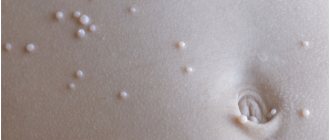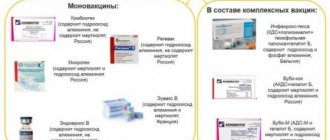Caesarean section is a method of delivery in which the fetus is removed through an incision in the anterior abdominal wall and uterus. Surgery always entails a difficult recovery period, and in some cases complications. Therefore, a caesarean section is performed only when natural childbirth becomes unsafe for mother and child.
The first cesarean section was performed by the German surgeon I. Trautmann in 1610. In those days, it was an emergency measure when natural childbirth was impossible. Antiseptics were not used in medicine, and the incision on the uterus was not sutured. In 100% of cases, the woman died after the operation. With the beginning of the use of broad-spectrum antibiotics, the risk of complications has decreased to a minimum.
“According to Rosstat, in 2010, 22% of pregnancies in Russia ended in caesarean section. In the West this figure is 25-28%.
Types of postoperative ailments
Caesarean section is performed for certain indications. During surgery, the patient's abdominal and uterine cavity are cut. After the doctor delivers the baby and placenta, stitches are placed. It is because of tissue damage that various complications can develop.
After a caesarean section, a large number of possible ailments are discovered. Problems occur in a variety of tissues and are of different nature. For this reason, the following possible ailments are considered:
- large loss of blood fluid;
- divergence of wound edges;
- improper formation of scar tissue;
- fistula formation;
- consequences of anesthesia;
- adhesive pathology;
- damage to the endometrial layer;
- inflammation of the wound;
- formation of hernial orifices.
All of these problems arise due to improper rehabilitation therapy. Problems may not arise if the woman follows all the recommendations of the observing specialist.
Examination before hospitalization
Approximately 2 weeks before the scheduled date of hospitalization, the woman receives a referral to the maternity hospital.
During this time, she needs to undergo a control examination, including:
- general urine and blood tests;
- biochemical blood test;
- coagulogram;
- establishing the Rh factor and blood group;
- examination for HIV, hepatitis, syphilis;
- survey smear on the flora;
- bacterial culture from the cervical canal;
- Fetal ultrasound;
- cardiotocography (CTG);
- Doppler study;
- ECG;
- consultation with a therapist;
- other studies as indicated.
As a rule, hospitalization is carried out several days before the ACL date prescribed by the surgeon. This is necessary so that specialists can conduct an additional check of the health of the mother and child, carry out drug treatment if necessary, and make a final decision on the specifics of the operation, type of anesthesia, etc.
On the appointed day, the woman in labor must appear at the maternity hospital, having with her the necessary list of documents: exchange card, referral for hospitalization, passport, insurance policy, results of all tests and expert opinions.
The exact list of things you are allowed to take with you should be clarified in advance.
Usually you are allowed to take the following with you:
- clothing: robe, low-cut shirt, special bra;
- rubber or leather slippers;
- towel;
- hygiene items for mother and child;
- disposable tableware;
- telephone.
Large loss of blood fluid
During natural labor, a woman loses a small amount of blood. The operation is accompanied by damage to the vascular fibers. For this reason, blood loss of up to one liter is observed.
The complication has an early and late nature. An early complication is diagnosed immediately after cesarean section. In this case, the reason is reduced blood clotting. This problem can be avoided. A fluid test is performed several hours before surgery. The choice of anesthesia is made only after receiving the results of the study.
The greatest danger is late bleeding. It appears due to suture dehiscence or damage to large blood vessels. Such blood loss is fraught with sepsis. The woman could die. Late onset of the problem can be detected in a timely manner using ultrasound examination.
This complication occurs due to thin walls of blood vessels, vigorous physical activity and carrying heavy objects. These causes must be completely excluded after surgery.
Caesarean section: indications
Indications for caesarean section are divided into absolute and relative. One of the absolute indications is enough to perform the operation. If there are relative indications, the doctor makes a decision on surgery based on their combination.
Absolute readings
- Complete placenta previa.
- Premature placental abruption.
- Anatomically narrow pelvis of III and IV degrees.
- History of 2 caesarean sections or 1 corporal section.
- Insolvent scar on the uterus (if it is damaged during an abortion).
- Beginning uterine rupture.
- Scar on the perineum of the third degree after a rupture during childbirth.
- Acute fetal hypoxia.
- Transverse position of the fetus after the rupture of water.
Relative readings
- Severe form of gestosis.
- History of pelvic and lumbar fractures.
- Pelvic position of a fetus weighing more than 3500 g.
- Multiple pregnancy with a single fetus in the pelvic position.
- Diseases of the brain, kidneys, cardiovascular system, retinal detachment.
- Umbilical cord prolapse.
Indications for cesarean section are identified during pregnancy. Then the woman is prepared for planned surgery. She needs to go to the hospital in advance to prepare for childbirth. But sometimes it happens that a woman is preparing for natural childbirth, but complications are discovered during labor. In this case, doctors perform an emergency caesarean section. The photo below clearly demonstrates the operation process.
Dehiscence of wound edges
A dangerous complication after a cesarean section is wound dehiscence. Sutures can be damaged both on the abdominal wall and on the uterine cavity. Wound rupture is observed due to vigorous physical activity or improperly selected underwear. An early onset of sexual activity may also be a cause.
Therapy is carried out using various methods. In rare cases, re-application of threads is used. The pathology can be cured with special treatment. The edges of the wound are washed with an antiseptic. A special drainage is inserted into the resulting wound. It allows fluid to drain out. After complete cleansing of the cavity, the drainage is removed.
Doctors also prescribe drug therapy. To avoid the development of inflammation, the specialist prescribes medications. The antibiotic substance helps clean the wound. After this, the wound quickly becomes covered with scar cells.
The quality of postoperative discharge should be closely monitored. If the secretion changes its structure, color and smell, you need to inform your doctor.
Preparing for surgery
With a planned caesarean section, the woman in labor is given a referral to the hospital 1-2 weeks before the birth. During this time, she takes tests and undergoes examinations. If necessary, doctors correct the woman’s health. They also monitor the child’s condition: they check the blood flow in the mother-placenta-fetus system using Doppler ultrasound, do CTG, and ultrasound.
If desired, a woman can donate plasma to a blood bank. If necessary during the operation, the mother in labor will be infused with her own blood components, not donor ones. Usually about 300 ml of plasma is donated. The blood is restored in 2-3 days.
A planned operation is usually performed at 38-39 weeks of pregnancy, based on the indicators of the child’s condition. Although the best moment for operative delivery is considered to be the beginning of labor. Then the cervix is open and postpartum discharge flows out better. Involution of the uterus passes faster, lactation occurs on time.
Caesarean sections are usually performed in the morning. In the evening they give a cleansing enema, shave the pubis, and give sleeping pills at night. The enema is repeated in the morning.
Schematic photo of childbirth by caesarean section
Improper formation of scar tissue
A complication such as a keloid scar is often detected. After a caesarean section, the wound becomes covered with cells that form a scar. This fabric gradually increases in thickness. An even and regular scar is formed.
But some patients experience irregular scar formation. The edges of such a scar are uneven, the thickness is uneven. This complication is called a keloid scar.
The cause of this disease is improper wound treatment. Pathology can also be detected due to infection. Keloid tissue does not harm women's health. The problem is cosmetic in nature. There are problems wearing tight-fitting clothes.
Keloid tissue can only be removed surgically. The scar is excised again. Cosmetic stitches are applied. With a small field of spread of atypical tissue, laser exposure helps. Atypical cells are dissolved by heat waves. A small burn remains. With proper care, the burn surface heals quickly.
The risk of developing this complication can be reduced by properly cleaning the wound and taking immunomodulatory drugs. Strengthening the immune system helps reduce pathological factors.
Fistula formation
A fistula is formed due to improper healing of one of the sutures. The cause of inflammation is poor-quality surgical material, wound infection and activation of the autoimmune system. The threads holding the edges of the muscle fiber are torn away. The formation of a fistula opening can be based on specific signs. You need to pay attention to the following symptoms:
- increased body temperature;
- slight compaction near the seams;
- pain in the area of the tumor;
- ulcerative lesions of the skin.
Fistula cannot be predicted. Often the reason is the lack of acceptance of the material for suturing the wound. Treatment is carried out using treatment with antiseptic drugs. You should also empty the fistula cavity of purulent contents. The doctor rinses the hole with a special solution. With proper treatment, the pathological hole gradually heals. If help is provided late, inpatient therapy is required. Timely assistance helps avoid unwanted complications.
Consequences of anesthesia
Anesthesia for caesarean section is carried out using various methods. Spinal and subarachnoid anesthesia is used. Full anesthesia is often used. The choice of pain relief method depends on the progress of pregnancy and the reasons for prescribing a cesarean section. After all methods of pain relief, the development of complications is observed. The following unwanted problems are considered:
- dizziness and nausea;
- migraine pain;
- lack of sensitivity in the lower extremities;
- consequences for the child.
Dizziness and nausea are considered common complications after anesthesia. These problems arise in the first days after a cesarean section. Removal of the active substance leads to a decrease in the intensity of nausea. Gradually it disappears.
In many cases, the development of migraine pain is observed. Migraines appear due to improper expansion of the vascular walls. For many women, the problem disappears on its own. Less commonly, pain persists throughout life.
After spinal anesthesia, loss of sensation in the lower extremities is observed in the first hours. This pathology goes away within a few days. In some cases, partial numbness of the limbs is observed, which develops spontaneously and also disappears suddenly.
The most unpleasant complication from anesthesia is the development of problems in the child. Due to the effects of anesthesia, the baby is weak and lethargic for the first hours after birth and does not latch on well. After a few days, the child’s activity returns to normal.
How does a caesarean section proceed in stages?
At the beginning of the operation, the body is prepared for anesthesia and a catheter is placed in the urinary canal to drain urine. During surgery, the bladder should be empty to make it easier for the doctor to access the uterus.
Anesthesia
The doctor chooses the method of pain relief based on the circumstances and health status of the woman in labor. General anesthesia is used in emergency cases. This type of anesthesia has a negative effect on the body of the mother and child: it causes respiratory depression in the child, and gastric contents can enter the mother’s respiratory tract and cause pneumonia. For a planned cesarean section, regional anesthesia is selected: spinal, epidural, or a combination of both. For pain relief, an injection is given in the lower back. During spinal anesthesia, the drug is injected into the fluid washing the spinal cord and the needle is removed. With an epidural, a tube is inserted under the skin along with a needle through which the medicine is delivered, and the needle is removed. The anesthesia procedure is painless, as the injection site is first numbed.
Spinal anesthesia during surgery
After anesthesia, the woman in labor is fenced off with a screen and the removal of the baby begins immediately. During the operation with regional anesthesia, the woman in labor is conscious. Immediately after birth, the baby is put to the breast.
Progress of the operation
The cesarean operation lasts 30-40 minutes. At 15-20 minutes, the baby is removed from the uterus.
- The skin in the lower abdomen is cut into a cross section 15 cm long.
- The subcutaneous fatty tissue, muscles, and peritoneum are cut layer by layer.
- An incision is made in the lower segment of the uterus.
- The amniotic sac is opened.
- The child is taken out.
- The umbilical cord is crossed.
- Delete the last one.
- The incision on the wall of the uterus is sutured.
- Restore the layers of the abdominal cavity.
- The seam is sutured on the skin with absorbable or silk threads.
The seam
Currently, caesarean sections are performed using an incision in the lower segment of the uterus. This is the thinnest place on the uterus, which has a small amount of muscle fibers. Due to this, after the involution of the uterus, this area becomes the smallest, and the scar also decreases in size. With this option of scar location, the incision on the uterus and on the anterior abdominal wall does not coincide, and the risk of adhesions of the uterus and peritoneum is minimal.
Adhesive pathology
After various surgical interventions, an adhesive process develops. Adhesions are formed from dense tissue. They connect the walls of various organs with each other. After a caesarean section, adhesions can form in the fallopian tubes. This complication is fraught with the following further problems:
- ectopic attachment of the fertilized egg;
- severe menstrual pain;
- problems with conception.
Adhesions in the reproductive system are dangerous for the development of subsequent pregnancy. Atypical tissue does not allow the fertilized egg to move into the uterus. The embryo attaches to the tube. Such a pregnancy can lead to rupture of the fallopian tube and removal of the ovary.
The danger lies in the development of severe menstrual pain. Problems may also arise with further conception. In many cases, adhesions can only be detected using ultrasound diagnostics. Removal of pathogenic material is carried out by additional surgical intervention.
Damage to the endometrial layer
For pregnancy to occur, the uterus is lined with endometrium. The fabric consists of three layers and serves as a kind of pillow for the fertilized egg. After a caesarean section, this layer is gradually restored. If an infection is introduced into the wound during surgery, bacteria may remain in the microflora. Pathogenic microorganisms cause atrophy of certain areas of the uterus. The tissue becomes inflamed.
Inflammation of the endometrium is accompanied by the development of various symptoms. Endometritis can be detected by increased body temperature, pain in the lower abdomen, and changes in the characteristics of cervical mucus.
Not all women experience external manifestations of the disease. In many cases, the disease is diagnosed after a complete medical examination. This complication is dangerous for reproductive ability. The disease does not allow a woman to plan a second pregnancy. The pathology responds well to drug exposure. The treatment regimen and medications are selected by a specialist.
Types of complications after surgery
Complications after a cesarean section are not uncommon, since the outcome of the procedure, like any other surgical intervention on the body, is unpredictable. The competence and high professionalism of the medical staff, properly organized care in the postoperative period can minimize the risks of unpleasant complications, but they cannot be completely eliminated. There are three large groups of difficulties that can arise after surgical delivery: complications due to anesthesia, from internal organs and from sutures.
On internal organs
Problems from the internal organs are largely due to the technology of the operation itself, and can be presented:
- large-scale blood loss. During a normal birth, a woman loses about a quarter of a liter of blood due to a large wound forming on the wall of the uterus after the placenta is separated. During surgical delivery, a fairly large incision is made in the abdominal wall and uterus, which inevitably leads to injury to numerous vessels, and the volume of lost blood increases accordingly. Life-threatening bleeding can occur with a vertical incision (implemented only in emergency situations), placental defects, or the presence of adhesions (especially important if the operation is not the first). The lost blood volume is replenished through IVs, since the weakened body is unable to actively implement the hematopoietic function;
- formation of adhesions. The process of scarring of damaged areas is a natural protective reaction of the body, but often after operations it spreads to other areas that were not affected during the delivery process. Thus, any elements in the abdominal cavity - intestinal loops, fallopian tubes and uterus, ovaries - can grow together with films or flagella, which will negatively affect their function. In such a situation, adhesive disease is diagnosed;
When dense adhesions of connective tissue form in a woman’s reproductive organs, the problem of secondary infertility becomes relevant. There is a high risk of disruption of the physiological process of sperm entering the fallopian tubes, the movement of the fertilized cell to the uterine cavity, etc. In such a situation, for pregnancy to occur, surgery to remove adhesions is necessary.
After surgery, adhesions may form in the abdominal cavity, disrupting the functioning of internal organs and preventing the onset of a new pregnancy.
- endometritis (inflammatory process on the mucous lining of the uterus). During surgery, a significant amount of air enters the abdominal cavity, and pathogenic microorganisms can enter with it. Inflammation can manifest itself either immediately after surgery or after a few days. Typical symptoms of endometritis after surgical delivery are: fever, chills, sleep and appetite disturbances, weakening of the pulse and the appearance of dark or purulent discharge and vaginal discharge along with lochia. To avoid such complications after surgery, women are prescribed a course of antibiotics;
- obstetric peritonitis - inflammation of the peritoneum due to infection. The source of the problem in most cases is a violation of the contractile function of the uterus due to the presence of a suture on it - lochia does not have the ability to quickly evacuate from the cavity, creating favorable conditions for the development of microorganisms.
When my friend became pregnant, she immediately knew that she would have a planned caesarean section for medical reasons. After the operation, she shared her impressions, and the most unexpected thing for me was that almost immediately after the anesthesia wore off, the doctors forced her to constantly turn over from one side to the other and begin to stand up. As they explained to her later, this is all necessary to prevent the formation of adhesions in the abdominal cavity.
After a cesarean section, I had endometritis, there was a discharge for 1.5 months, on an ultrasound they saw pieces of the placenta, I was taken to the hospital for cleaning, but in the end I managed without it, I was treated with antibiotics for a week.
Sveta
https://forum.forumok.ru/index.php?showtopic=15698
At the seams
Complications from sutures can develop both in the early postoperative period and much later - even several years after the intervention. Primary difficulties with sutures include:
- inflammatory process. If the wound is treated incorrectly or insufficiently, or infection is detected, inflammation begins. The main symptoms of this complication are increased redness, including in the area around the incision, excessive swelling of the operated area, increased temperature, and possible discharge of blood and pus. In such a situation, the only treatment method is the use of antibiotics;
- activation of bleeding. In a situation where the sutures are not applied tightly enough, the vessels are not properly sutured, or during dressing procedures there is careless handling of the wound, bleeding may begin, including subcutaneous bleeding with the formation of hematomas;
- dehiscence of the sutured wound. This rarely happens, since high-quality modern suture materials are used today, but a complication is possible, especially if there is a hidden infection in the body that prevents healing, or the woman in labor ignores the doctors’ instructions and lifts weights. In such a situation, re-suturing of the incision is required.
They performed a caesarean on me, the operation went well, on the 3rd day they took off the bandage and let me go into the shower, while I was in the maternity hospital everything was ok, but when I got home the stitch began to fester. The temperature was over 38, at first I didn’t understand what was wrong, I thought it was just a relief, fortunately a midwife I knew was working so she sent me in an emergency to the maternity hospital to see a gynecologist, and there it turned out that I was in horror and the nightmare was still festering. They cut him almost to the quick and prescribed antibiotics.
Waist
https://forum.forumok.ru/index.php?showtopic=15698
The worst complication after the cesarean section was that one of my internal seams came apart and began to fester, as it turned out later, they had to cut me again, clean the seam and darn it again.
Anastasia
https://baby.dn.ua/forum/index.php?topic=736.0
Even after the early postoperative period has passed safely and the surgical wounds have healed, the woman may face complications in the future related specifically to the condition of the sutures:
- fistulas They can form around applied sutures (ligatures) due to infection entering the wound or the body’s rejection of the suture material. The problem does not make itself felt immediately, but gradually develops over several months. The suture area thickens, turns red, becomes painful, and it is also possible for pus to separate from the formed hole. The method to eliminate the problem is to remove the suture material from the tissue;
- formation of a keloid scar. At the site of the suture, tissue grows, forming a massive and uneven scar. Usually this condition is caused by the characteristics of the patient’s skin; it is a cosmetic defect and does not pose a health hazard. The problem can be corrected using laser and ultrasound cosmetology methods, or surgically (scar excision);
- in rare cases, after surgical delivery, a hernia may form at the site of the suture. The risks increase when the operation is performed through an emergency longitudinal incision and during several operations following each other (when a woman has children of the same age). A hernia can only be eliminated surgically.
After surgery, a cosmetic problem may arise - tissue growth at the suture site or a keloid scar
Complications due to anesthesia
Today, two types of anesthesia can be used for caesarean section: general and epidural. In the first case, the woman is unconscious, and in the second, sensitivity is absent only in the lower part of the body, thanks to which the woman in labor can see her baby immediately after doctors remove him from the uterus. Both technologies have risks of complications associated with both the route of drug administration and the characteristics of their effects. Let's consider the possible consequences of general anesthesia:
- damage to the mucous membrane of the throat due to the insertion of a tube for breathing;
- disruption of the nervous and muscle activity of the newborn due to the influence of drugs on him;
- nausea and vomiting in the mother;
- increased excitability and severe headache (up to three days);
- disruption of the digestive tract. The administered drugs can weaken intestinal motility, which is why women after cesarean section often suffer from constipation.
The introduction of epidural anesthesia allows a woman to remain conscious when the baby is born.
During spinal anesthesia, the experience of the specialist who places the catheter into the epidural sheath of nerve fibers in the spinal canal is of great importance. A woman may encounter difficulties in the postoperative period:
- pain in the head and back;
- spinal block - painful sensations due to a puncture of the dura mater of the spinal cord;
- heartbeat disturbance, there is also a risk of respiratory arrest;
- inhibition of newborn activity;
- oxygen starvation of the fetus.
Other complications
After surgery, a complication such as numbness in the abdominal area is often encountered. The thing is that during the surgical intervention the formed nerve branches are disrupted, which makes the conduction of sensations much more difficult. Restoring nerve endings is a long process, and numbness in the area of the surgical field can be felt for up to a year.
If the mother had problems with the circulatory and endocrine systems even before giving birth (thrombosis, varicose veins, coagulation disorders, thyroid disease, etc.), then in the postoperative period there is a high probability of severe swelling of the legs. The mother’s condition is monitored for the first 7–14 days after surgery, and if the swelling does not subside, then drug therapy is used.
After the first CS, the numbness did not go away, my daughter is already 3.5 years old. But every year it becomes less and less and does not bother me. Now after the second one there is also numbness. This is always the case when cutting.
Tali
https://www.babyblog.ru/community/post/vosstanovlenie/1453975
Wound inflammation
A caesarean section requires proper post-operative care from the woman. If the wound is not cleaned in a timely manner, a complication in the form of bacterial infection is detected.
Pathogenic microorganisms multiply quickly in the wound surface. The accumulation of pathogenic material is accompanied by inflammation. In this case, the following unpleasant signs are detected:
- redness of the edges of the incision;
- pain;
- discharge of fluid from the wound;
- suppuration of the sutures.
This complication is dangerous for the healing process. If a complication is detected, you should immediately visit a doctor. Inflammation can be removed with the help of antiseptic drugs. The specialist also prescribes additional antibiotics. Daily treatment is carried out twice a day. Only these methods will help avoid further development of the disease.
Hernial orifice
A hernia forms after a caesarean section performed with a longitudinal incision. During this operation, the muscle tissue of the peritoneum is moved apart to increase the field of access to the internal organs. After a caesarean section, the tissue returns to its original location. Restoration of the muscle frame does not always proceed correctly. In this case, abdominal organs can become trapped in the space between the muscle fibers. This pathology is called a hernia.
This complication is detected when the doctor’s recommendations are not followed. Hernial orifices are formed during increased physical activity and carrying heavy objects. A hernia can only be repaired through additional surgery. There are no other methods of struggle.
The day before surgery
Preparation for a planned cesarean section necessarily includes an additional conversation between the patient and the surgeon and anesthesiologist. Specialists talk about the progress of the operation and the features of the recovery period, and also clarify whether the woman in labor is allergic to certain medications. Then the expectant mother must sign a consent form for surgery.
It is recommended to spend the last day before the baby is born in as calm an environment as possible. The woman in labor should get enough sleep and gain strength. As a rule, the doctor prescribes a single dose of a mild sedative.
During the day, meals should be light and dietary. For dinner (at approximately 18-00) you are allowed to drink one glass of tea or kefir. After this time, no food or liquid is allowed until the operation itself. This is due to the fact that during anesthesia, residual stomach contents can clog the respiratory tract of the woman in labor.
Also, before the operation, you should carry out the necessary set of hygiene procedures: take a shower, remove excess pubic hair.
Doctors' recommendations
Complications can be avoided. To do this, you must follow the following rules:
- timely cleansing and treatment of the wound;
- refusal of excessive loads;
- following all doctor's recommendations.
The woman’s main task is to comply with all recommendations received upon discharge from the hospital.
It is also necessary to clean the seams correctly and promptly. A medical professional will explain how to properly clean the wound. You should also avoid high physical activity in the first months after surgery. Caesarean section is used for certain indications. The operation does not always go smoothly. Complications may arise. To quickly and effectively eliminate the disease, you need to go to the hospital.
Recovery after caesarean section
After a caesarean section, it will take time for the body to recover. Wounds after incisions heal in about a week to a week and a half, and full recovery occurs in about a month and a half to two months. At this time, it is important to follow the recommendations of doctors:
- Move more to avoid the growth of connective tissues (adhesions). To relieve stress on the spine and support the abdominal muscles, a postpartum bandage is allowed to be worn in the first weeks.
- To avoid bleeding, do not take a hot bath and avoid visiting the bathhouse.
- Do not lift heavy objects (maximum 3 kg)
- Do special exercises to strengthen the muscles of the abdomen, perineum and pelvis, as well as for the normal functioning of intestinal motility
- In case of redness, hematoma or purulent discharge, consult a doctor immediately to avoid the spread of infection.











